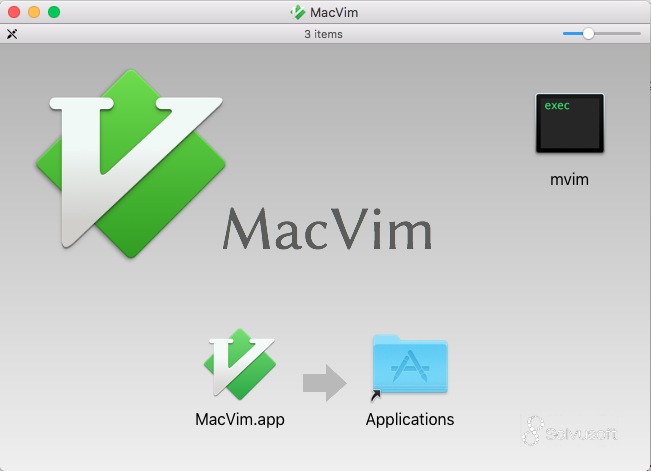

- OPENING MACVIM THROUGH TERMINAL HOW TO
- OPENING MACVIM THROUGH TERMINAL INSTALL
- OPENING MACVIM THROUGH TERMINAL UPDATE
- OPENING MACVIM THROUGH TERMINAL PROFESSIONAL
- OPENING MACVIM THROUGH TERMINAL MAC
But all in all, i’ve found it to be a nice ol’ reliable. It works based on his own name, e.g if its name starts with m or g will start the GUI version, otherwise the console version. And I’ve run into times when I wanted macvim to open from a different application without blocking until it finishes running, and other times when I’ve wanted it to block until it finishes running. The mvim is universal starting (bash) script for the MacVim. If you have multiple MacVims floating around your machine, you might not get the right one without setting a VIM_APP_DIR environment variable. There are a few quirks to this old script.

It has some extra stuff for making sure parameters are passed correctly. The old mvim file used to search through its own list of locations to find a MacVim app and then launch it. So I copied my mvim from my old computer and just set it up there. But in Terminal, the following command doesnt do anything either: zathura -synctex-forward. Somewhere on stack overflow said to copy the mvim file from MacVim.app into your path, but that didn’t work from me. Zathura An Open Source Document Viewer for Linux. I want mvim to be inside of my path so that I know it will definitely work as my visual editor no matter what. I don’t know of any obvious pros/cons to the new way vs the old way. The new way, – I guess – is to just copy MacVim to applications and then set up an alias in your bash_profileĪlias mvim = '/Applications/MacVim.app/Contents/bin/mvim' And its nothing like it was the last time I set up a computer. And then they moved the mvim script inside of the app file. However, it seems there was some arguments about something involving whether the mvim script should open MacVim in a gui, or in the terminal. And there was a readme that said where to copy the bash script.
OPENING MACVIM THROUGH TERMINAL PROFESSIONAL
The name of the github page owner isn’t super professional seeming, so the only reason I think I linked to the right page is because if you open a copy of MacVim and go to Help -> MacVim Website and then click on the github page, it takes you to where I linked.įrom there, you need to click on releases at the top of the github page, and just download the dmg for whatever release you want.īack in the day, the dmg contained MacVim.app and mvim a bash script. here it is again. I will admit to running into some issues. I’ve mentioned the github page, and even linked to it.
OPENING MACVIM THROUGH TERMINAL INSTALL
It doesn’t actually put MacVim into the applications folder, so you would assume you could just install through homebrew, and copy the app into /Applications from the github release page, but this actually means you have two copies of the MacVim.app and that means double the updates. The biggest benefit to installing through homebrew is that you have mvim available from the terminal right out of the gate. As a result, it doesn’t support the plugins I use. It’s compiled with different support for python and ruby than what you get if you go grab MacVim from the GitHub releases page. Use Vimer tool to ensure that whenever a new file is opened from terminal, it opens as a new buffer in an existing GVim/MacVim window (not a new instance of. To exit vim command mode, type in :q and press Enter.The reason I don’t like it is simple.UPDATE: A bit of clarification about brew and brew cask. You'll enter vim command mode once you double-click the icon. For MacVim, you can install with: brew cask install macvim You should then be able to launch MacVim like you do any other macOS app, including mvim or open -a MacVim from a terminal session.At this point, you can run the MacVim GUI by double-clicking the icon.
dmg file, and copy MacVim.app to /Applications Go to for the latest version of MacVim and download MacVim.dmg.There are other options though! If you're like me, you're wondering what the difference is between MacVim and Vim. To figure out what your local version of Vim, enter the command vim -v.
OPENING MACVIM THROUGH TERMINAL MAC
If you are not a Mac user, click here for device-specific instructions (Unix or MS-Windows).

OPENING MACVIM THROUGH TERMINAL UPDATE
Sadly, it's not the latest stable version so I'm going to update it to ^ 8.1.x. Check out the latest stable Vim version at vim.org/download.php. The most current version at this time of writing is Vim 8.1. No need to install if your current version is the latest stable version.
OPENING MACVIM THROUGH TERMINAL HOW TO
I spent like 30 mins trying to figure out how to install Vim when I first heard about it, so I'm saving you the wasted effort: Vim comes pre-installed in MacOS. You technically don't need to leave the Terminal to code. It's a powerful open-source text editor that allows you to edit your text files on the command line.


 0 kommentar(er)
0 kommentar(er)
